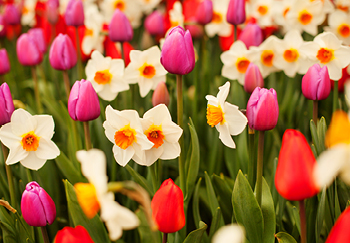When to Plant Daffodil Bulbs for Spring Displays
October 20th, 2023 | Categories
When you think of spring, you think of Daffodils. When they appear with their vibrant yellow blooms, it’s a sure sign to all that spring has finally arrived. Daffodils grow equally well in the ground on their own, amongst busy beds, and grass, as they do in containers, and being perennial, they will come back year after year with little to no attention. Daffodils are such a common sight in spring that many people come to disregard them a little bit. However, there are dozens of different types of the humble daffodil that come in a wide range of flower shades, shapes, and sizes, which many people don’t realise. Some are white and have different looking flowers to the traditional yellow daffodil. Some are as small as 5cm, and some as tall as 50cm. So there’s a lot more to daffodils than one might assume.
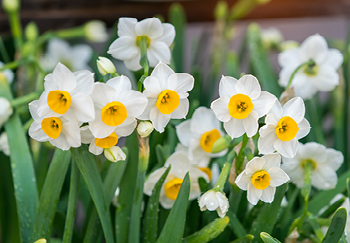
When to Plant Daffodil Bulbs for Spring Displays
The best time to plant daffodil bulbs is in autumn, ideally September or October. The ground is still warm from the summer sun, and moist from the start of the autumn rains. This gives the bulbs the best chance to establish themselves before the winter freeze sets in, so they’ll be ready to bloom in spring.
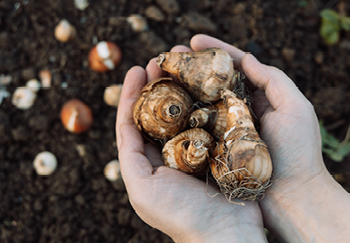
How to Plant & Grow Daffodil Bulbs Easily
Planting daffodil bulbs is very easy and straightforward. They enjoy full sun, though will tolerate a lightly shaded spot, and a moist, well-draining soil, so choose an appropriate spot.
When it comes to planting, dig a hole about twice as deep as the bulb is tall. Fill the bottom with a good quality multi-purpose compost and for best results also use some bulb starter to give it a perfect start of nutrients. Then, place the bulb in the hole with the pointy end facing up (this might sound funny, but it wouldn’t be the first time even a seasoned gardener planted the wrong way up), gently pressing them into the compost. Then place some more compost on top of the bulbs, gently firming it in without pressing down hard, and then infill the rest of the hole with the soil you dug out earlier. Water thoroughly after planting too with a fine rose watering can. Unless it’s an unusually warm and dry autumn, it’s likely this will be the only watering needed until spring.
If planting several bulbs in the same spot, the same principle of depth applies, however be sure to dig a wider hole to give each bulb a nice amount of space; at least twice the width of each bulb.
If opting to plant daffodil bulbs in a container, the same process applies, but ensure to choose a container that is at least 30cm deep and plant the bulbs a bit deeper than you would if planting in the ground. The great thing about planting in containers is you can simply move it around to get as much sun as possible and keep the soil nice and moist.
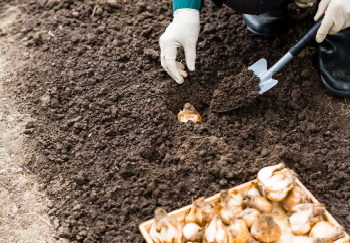
How to Care for Daffodils
Daffodils don’t need a lot of ongoing care usually. They do well in most soil types and positions as long as they get enough sun. And unless you have planted them in a dry spot, they should get enough water from the moisture in the soil. Be sure to water in very dry periods though. Additionally, you can apply a general fertiliser evenly on the soil surface around the bulbs each spring to provide them with the nutrients they need to look their best.
If you want to keep daffodils in the container for several years following first planting, it is important to feed the bulb generally as it will use up the nutrients in the compost in the pot. Do this while the foliage is still green as it will have used much of its food stores by that point. You can apply the general fertiliser each spring as above and follow up with a high potash fertiliser once a week once the flowers appear. This should keep them looking vibrant and lush until they die off and go dormant for the next year.
Finally, if you want to deadhead the faded blooms after flowering this will divert all the energy into the bulb rather than forming seeds. It also keeps the display looking nice and tidy. However this is generally not essential with daffodils.
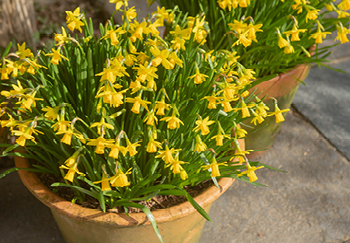
Types of Daffodils
There are dozens of different daffodils to choose from, here are some popular ones and some you might never have heard of:
Dutch Master
The classic yellow trumpet shaped daffodil.
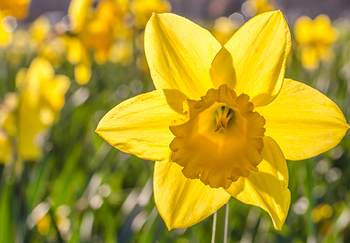
Tete A Tete
A mini flowering daffodil smaller in height.
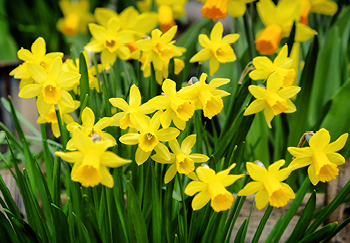
King Alfred
The daffodils within this collection are a wonderful bold yellow colour in a typical trumpet shaped flower with a large flower centre.
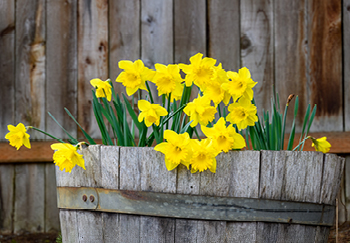
Poeticus Var. Recurvus
The Poeticus Var. Recurvus is a more unique looking daffodil with bright white petals and a yellow centre trumpet that has a reddish-pink rim of colour.
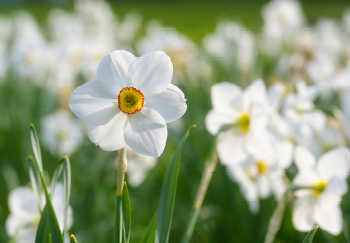
Golden Delicious
The Golden Delicious daffodil is a garden favourite with its wonderful bright yellow flowers in the classic trumpet shape.
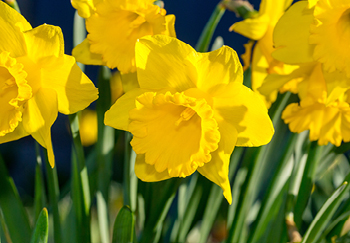
Golden Echo
Golden Echo Daffodils are similar to Golden Delicious, but in two-tone with their bright yellow trumpets and paler yellow petals still just as wonderful.
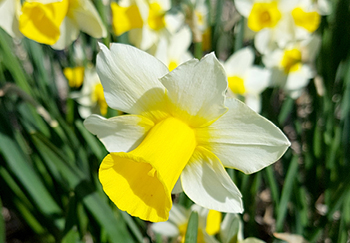
Snow Baby
Snow Baby Daffodils are a wonderfully bright white in colour in the typical trumpet shaped flower.
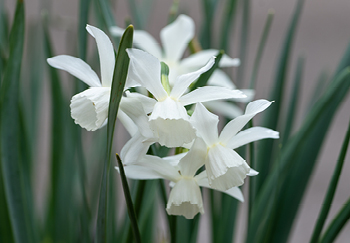
Double Replete
The Double Replete has delicate pale white petals, complimented by a strong pink flower centre.
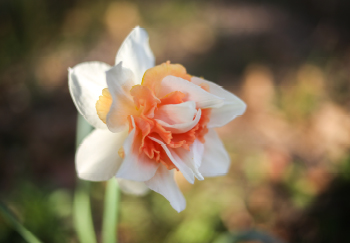
Jetfire
The Jetfire is a dwarf daffodil with a distinctive orange flower centre with bright yellow petals and a slight fragrance.
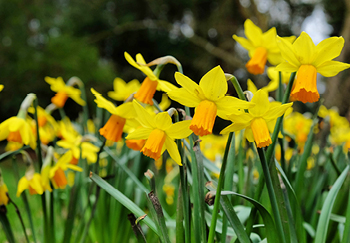
Minnow
The dwarf Minnow has many flowers with white petals and a yellow centre.
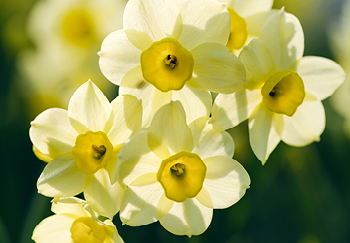
Paperwhite Ziva
Paperwhite Ziva is an indoor flowering narcissus which has a strong fragrance.
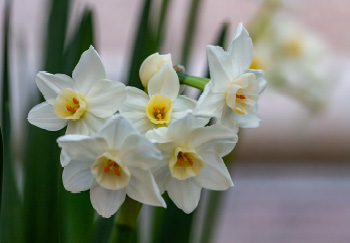
Sir Winston Churchill
Sir Winston Churchill is a beautiful light-coloured daffodil with their white flowers and spring yellow centre.
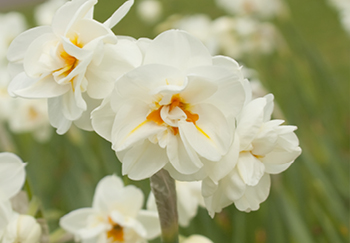
Thalia
The Thalia Daffodil can grow to up to 35cm and can produce stunning 3-6 pure white flowers per bulb.
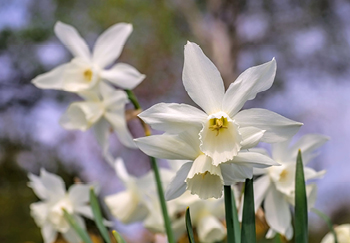
Martinette
The Martinette Daffodil is a lovely variety with a dark yellow-orange centre and delicate bright yellow petals. It is fragrant too.
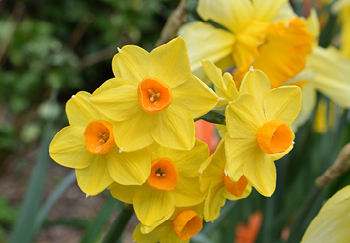
Add Daffodils to your Garden for Fantastic Spring Colour
Planting daffodil bulbs is a great way to add wonderful colour to your garden. Remember to plant in the autumn, choose a sunny location with well-drained soil, and look forward to a beautiful display of flowers when spring arrives year after year with little to no maintenance. Happy gardening!
